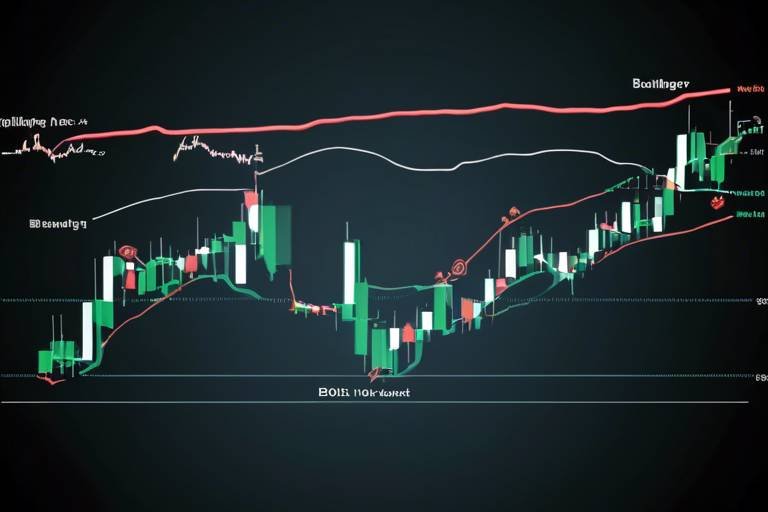The Benefits of Setting Trading Goals
Setting trading goals is crucial for success in the financial markets. Just like a ship needs a destination to navigate the vast ocean, traders need clear objectives to chart their course through the complex world of trading. By establishing specific, measurable, achievable, relevant, and time-bound (SMART) goals, traders can enhance their focus, discipline, and overall performance. In this article, we will explore the various advantages of goal-setting in trading, including how it can improve focus, enhance discipline, and facilitate better performance tracking.
Establishing clear trading goals helps traders concentrate on their strategies, minimizing distractions. Imagine trying to read a book in a noisy café; it’s nearly impossible to absorb the information. Similarly, in trading, distractions can lead to poor decisions and missed opportunities. When traders set specific goals, they create a roadmap that guides their actions, allowing them to filter out noise and hone in on what truly matters. This focused approach can lead to more informed decisions and ultimately better trading outcomes, as traders are less likely to deviate from their plan.
Discipline is key in trading. Setting specific goals encourages traders to stick to their plans, reducing impulsive decisions and promoting a consistent trading routine. Think of discipline as the backbone of successful trading; without it, even the best strategies can falter. By committing to their goals, traders cultivate habits that support their long-term success. This discipline not only helps in adhering to trading strategies but also in managing emotions that can cloud judgment.
With defined goals, traders can hold themselves accountable for their actions. This accountability fosters a sense of responsibility, motivating traders to adhere to their strategies and improve their performance. When traders know they have set specific targets, they are more likely to reflect on their decisions and outcomes. This self-assessment can lead to a deeper understanding of their trading style and the adjustments needed for continued growth.
Regularly assessing progress towards goals allows traders to identify strengths and weaknesses. This self-reflection is essential for continuous improvement and adapting strategies as needed. For instance, a trader might realize they are consistently underperforming in a particular market segment. By reviewing their goals and performance, they can pivot and focus on areas where they excel, ultimately leading to better results.
Setting achievable milestones can boost motivation. As traders reach their goals, they gain confidence, which can lead to more ambitious objectives and sustained engagement in trading. This cycle of setting, achieving, and setting new goals creates a positive feedback loop that keeps traders motivated and eager to improve. For example, if a trader sets a goal to increase their account balance by 10% in a quarter and achieves it, they may then set a more challenging goal for the next quarter.
Tracking progress against set goals provides valuable insights into trading effectiveness. This data can inform future strategies, helping traders refine their approach and enhance profitability. By maintaining a trading journal or using software to track their performance, traders can visualize their journey and make informed decisions based on historical data. This analytical approach transforms trading from a gamble into a calculated endeavor.
Goal-setting encourages traders to define their risk tolerance. By establishing clear limits, traders can manage their risks more effectively and protect their capital. Just like a safety net for an acrobat, these limits ensure that traders do not fall too far when the market takes a downturn. Understanding one’s risk appetite is vital for long-term success in trading.
Setting goals related to position sizing helps traders determine how much to invest in each trade. This approach reduces the likelihood of significant losses and supports a balanced portfolio. For instance, if a trader aims to risk only 1% of their capital on any single trade, they can calculate their position size based on their stop-loss strategy. This disciplined approach to risk management can be the difference between staying in the game and facing devastating losses.
Clear trading goals can help manage emotions during volatile market conditions. By adhering to their plans, traders can avoid emotional decision-making that often leads to poor outcomes. When the market is turbulent, it’s easy to succumb to fear or greed. However, having well-defined goals acts as an anchor, allowing traders to remain calm and focused on their strategy, rather than being swayed by the emotional currents of the market.
- What are trading goals?
Trading goals are specific objectives that traders set to guide their trading activities and measure their performance. - Why is it important to set trading goals?
Setting trading goals helps improve focus, enhance discipline, and track performance, ultimately leading to better trading outcomes. - How can I set effective trading goals?
Effective trading goals should be SMART: Specific, Measurable, Achievable, Relevant, and Time-bound. - What should I do if I don’t meet my trading goals?
Reflect on your performance, identify areas for improvement, and adjust your strategies or goals accordingly.

Improved Focus
Setting trading goals is crucial for success in the financial markets. This article explores various advantages of goal-setting, including improved focus, enhanced discipline, and better performance tracking.
Establishing clear trading goals helps traders concentrate on their strategies, minimizing distractions. Imagine trying to read a book while the TV is blaring in the background; it’s nearly impossible to absorb any information. Similarly, without defined goals, traders can easily get sidetracked by market noise, rumors, or the latest trends. By focusing on specific objectives, traders can filter out the irrelevant chatter and hone in on what truly matters for their trading success.
When traders set clear goals, they create a roadmap for their trading journey. This roadmap not only outlines what they aim to achieve but also emphasizes the steps required to get there. For instance, a trader might set a goal to achieve a specific percentage return on their portfolio over a quarter. With this target in mind, they can concentrate on developing strategies that align with this objective, such as identifying high-potential stocks or optimizing their entry and exit points. This focused approach can lead to more informed decisions and ultimately better trading outcomes.
Moreover, having a clear goal can significantly reduce the emotional stress that often accompanies trading. When traders know what they are aiming for, they are less likely to be swayed by fleeting market fluctuations. Instead of reacting impulsively to every price movement, they can maintain their composure and stick to their strategy. This discipline is a vital component of successful trading.
In addition, a focused mindset encourages traders to engage in continuous learning and improvement. They are more likely to seek out educational resources, attend webinars, or follow market analysts who align with their trading goals. This proactive approach not only enhances their knowledge but also reinforces their commitment to their trading objectives.
To summarize, improved focus through goal-setting can lead to:
- Minimized distractions and enhanced decision-making.
- A clear roadmap for trading strategies.
- Reduced emotional stress and impulsive reactions.
- Continuous learning and improvement.
Discipline is key in trading. Setting specific goals encourages traders to stick to their plans, reducing impulsive decisions and promoting a consistent trading routine.
With defined goals, traders can hold themselves accountable for their actions. This accountability fosters a sense of responsibility, motivating traders to adhere to their strategies and improve their performance.
Regularly assessing progress towards goals allows traders to identify strengths and weaknesses. This self-reflection is essential for continuous improvement and adapting strategies as needed.
Setting achievable milestones can boost motivation. As traders reach their goals, they gain confidence, which can lead to more ambitious objectives and sustained engagement in trading.
Tracking progress against set goals provides valuable insights into trading effectiveness. This data can inform future strategies, helping traders refine their approach and enhance profitability.
Goal-setting encourages traders to define their risk tolerance. By establishing clear limits, traders can manage their risks more effectively and protect their capital.
Setting goals related to position sizing helps traders determine how much to invest in each trade. This approach reduces the likelihood of significant losses and supports a balanced portfolio.
Clear trading goals can help manage emotions during volatile market conditions. By adhering to their plans, traders can avoid emotional decision-making that often leads to poor outcomes.
Q1: Why are trading goals important?
A1: Trading goals provide direction and focus, helping traders make informed decisions and stick to their strategies.
Q2: How can I set effective trading goals?
A2: Effective trading goals should be specific, measurable, achievable, relevant, and time-bound (SMART).
Q3: What should I do if I fail to meet my trading goals?
A3: Reflect on your strategies, identify areas for improvement, and adjust your goals as necessary to ensure they remain realistic and attainable.

Enhanced Discipline
Setting trading goals is crucial for success in the financial markets. This article explores various advantages of goal-setting, including improved focus, enhanced discipline, and better performance tracking.
Establishing clear trading goals helps traders concentrate on their strategies, minimizing distractions. This focused approach can lead to more informed decisions and ultimately better trading outcomes.
Discipline is the backbone of successful trading. When traders set specific goals, they create a roadmap that guides their actions and decisions. It’s like having a personal trainer in the gym; without a plan, it's easy to get sidetracked by distractions or temptations. By sticking to their goals, traders can avoid impulsive behaviors that often lead to regrettable losses.
Moreover, this disciplined approach promotes a consistent trading routine. Imagine trying to bake a cake without following a recipe; you might end up with a disaster. Similarly, without discipline in trading, the likelihood of erratic performance increases. Setting goals encourages traders to adhere to their plans, making it easier to maintain a steady course even when the market gets turbulent.
With defined goals, traders can hold themselves accountable for their actions. This accountability fosters a sense of responsibility, motivating traders to adhere to their strategies and improve their performance. It's like having a buddy system; when you know someone is watching your progress, you're more likely to stick to your commitments.
Regularly assessing progress towards goals allows traders to identify strengths and weaknesses. This self-reflection is essential for continuous improvement and adapting strategies as needed. Think of it as checking your GPS while on a road trip; if you take a wrong turn, you can recalibrate your route to stay on track.
Setting achievable milestones can boost motivation. As traders reach their goals, they gain confidence, which can lead to more ambitious objectives and sustained engagement in trading. It’s like climbing a mountain; each small peak conquered gives you the strength and motivation to tackle the next one. This cycle of achievement creates a positive feedback loop, encouraging traders to strive for even greater success.
Tracking progress against set goals provides valuable insights into trading effectiveness. This data can inform future strategies, helping traders refine their approach and enhance profitability. Just as athletes review their performance stats to improve, traders benefit tremendously from evaluating their outcomes against their goals.
Goal-setting encourages traders to define their risk tolerance. By establishing clear limits, traders can manage their risks more effectively and protect their capital.
Setting goals related to position sizing helps traders determine how much to invest in each trade. This approach reduces the likelihood of significant losses and supports a balanced portfolio.
Clear trading goals can help manage emotions during volatile market conditions. By adhering to their plans, traders can avoid emotional decision-making that often leads to poor outcomes.
- Why are trading goals important?
Trading goals provide direction and focus, helping traders make informed decisions and avoid impulsive actions.
- How can I set effective trading goals?
Effective trading goals should be specific, measurable, achievable, relevant, and time-bound (SMART).
- What should I do if I fail to meet my trading goals?
Use it as a learning opportunity. Assess what went wrong and adjust your strategy accordingly.
- Can setting goals improve my trading performance?
Yes! Setting clear goals enhances focus, discipline, and accountability, leading to better trading outcomes.

Accountability
Accountability in trading is like having a personal coach who keeps you on track, ensuring you stick to your game plan. When you set defined trading goals, you create a framework that allows you to hold yourself responsible for your actions. This sense of responsibility can be a game-changer, as it motivates you to stay disciplined and committed to your trading strategy. Imagine trying to run a marathon without a training schedule; it would be easy to skip workouts and lose focus. Similarly, without clear goals, traders can easily stray from their plans, leading to impulsive decisions and potential losses.
By implementing accountability measures, such as tracking your progress and reviewing your trades regularly, you can cultivate a strong sense of ownership over your trading journey. This can be done through various methods:
- Journaling: Keeping a trading journal where you document your trades, strategies, and emotions can provide invaluable insights. It allows you to reflect on what worked and what didn’t, fostering a deeper understanding of your trading behavior.
- Peer Accountability: Joining trading groups or forums can create a supportive environment where traders share their goals and progress. This camaraderie encourages accountability, as you’re more likely to stick to your commitments when others are aware of your objectives.
- Regular Reviews: Setting aside time to review your performance against your goals can help you identify areas for improvement. This process not only highlights your achievements but also uncovers patterns that may be hindering your success.
In essence, accountability transforms trading from a solitary endeavor into a structured process where you are actively engaged in your progress. It helps you stay aligned with your goals, making it easier to navigate the often tumultuous waters of the financial markets. When you know that your success hinges on your adherence to your trading plan, you’re less likely to make hasty decisions that could derail your progress.
In conclusion, embracing accountability in your trading practice not only enhances your discipline but also empowers you to take control of your financial future. By committing to your goals and holding yourself accountable, you pave the way for consistent improvement and greater success in the trading arena.
- What are trading goals? Trading goals are specific objectives that a trader sets to guide their trading activities, such as achieving a certain percentage return, limiting losses, or improving trading strategies.
- How can I hold myself accountable in trading? You can hold yourself accountable by maintaining a trading journal, joining trading communities, and regularly reviewing your performance against your goals.
- Why is accountability important in trading? Accountability is crucial because it encourages discipline, helps you stay focused on your trading strategy, and reduces the likelihood of impulsive decisions that can lead to losses.
- What should I include in my trading journal? Your trading journal should include details of each trade, such as entry and exit points, the reasoning behind the trade, emotions felt during the trade, and lessons learned.

Self-Assessment
Setting trading goals is crucial for success in the financial markets. This article explores various advantages of goal-setting, including improved focus, enhanced discipline, and better performance tracking.
Establishing clear trading goals helps traders concentrate on their strategies, minimizing distractions. This focused approach can lead to more informed decisions and ultimately better trading outcomes.
Discipline is key in trading. Setting specific goals encourages traders to stick to their plans, reducing impulsive decisions and promoting a consistent trading routine.
With defined goals, traders can hold themselves accountable for their actions. This accountability fosters a sense of responsibility, motivating traders to adhere to their strategies and improve their performance.
Regularly assessing progress towards goals allows traders to identify strengths and weaknesses. This self-reflection is essential for continuous improvement and adapting strategies as needed. Think of self-assessment as a mirror that reflects not just your trading results, but also your decision-making processes. By taking a step back and analyzing your trades, you can uncover patterns and behaviors that may be hindering your success.
For instance, you might ask yourself questions like:
- What strategies worked well for me this month?
- Were there any trades that I regretted? What led to those decisions?
- Am I sticking to my risk management rules?
By documenting your thoughts and results in a trading journal, you can create a roadmap for improvement. This journal acts as a valuable tool, providing insights into your trading psychology and decision-making processes over time. It’s not just about the numbers; it’s about understanding your emotional responses and learning from them.
Additionally, self-assessment can help you set more realistic and achievable goals for the future. By recognizing what you did well and where you struggled, you can refine your strategies and set targets that challenge you without being overwhelming. This ongoing cycle of evaluation and adjustment is what keeps traders on the path to success.
Tracking progress against set goals provides valuable insights into trading effectiveness. This data can inform future strategies, helping traders refine their approach and enhance profitability.
Goal-setting encourages traders to define their risk tolerance. By establishing clear limits, traders can manage their risks more effectively and protect their capital.
Setting goals related to position sizing helps traders determine how much to invest in each trade. This approach reduces the likelihood of significant losses and supports a balanced portfolio.
Clear trading goals can help manage emotions during volatile market conditions. By adhering to their plans, traders can avoid emotional decision-making that often leads to poor outcomes.
Setting trading goals helps improve focus, enhance discipline, and allows for effective performance tracking, ultimately leading to better trading outcomes.
It's beneficial to assess your trading goals regularly, perhaps on a monthly or quarterly basis, to ensure you are on track and to make necessary adjustments.
Yes, setting too many goals can be overwhelming. It's essential to prioritize and focus on a few key objectives to maintain clarity and direction in your trading.
Setting achievable milestones and celebrating small wins can boost your motivation. Keeping a trading journal and reflecting on your progress can also help maintain your enthusiasm.

Motivation
Setting trading goals is crucial for success in the financial markets. This article explores various advantages of goal-setting, including improved focus, enhanced discipline, and better performance tracking.
Establishing clear trading goals helps traders concentrate on their strategies, minimizing distractions. This focused approach can lead to more informed decisions and ultimately better trading outcomes.
Discipline is key in trading. Setting specific goals encourages traders to stick to their plans, reducing impulsive decisions and promoting a consistent trading routine.
With defined goals, traders can hold themselves accountable for their actions. This accountability fosters a sense of responsibility, motivating traders to adhere to their strategies and improve their performance.
Regularly assessing progress towards goals allows traders to identify strengths and weaknesses. This self-reflection is essential for continuous improvement and adapting strategies as needed.
Setting achievable milestones can significantly boost a trader's motivation. Think of it like climbing a mountain; each goal you set is a base camp that brings you closer to the summit. As traders reach their goals, they not only gain confidence but also develop a deeper connection to their trading journey. This sense of accomplishment can be incredibly energizing, pushing them to set even more ambitious objectives.
Moreover, motivation in trading isn't just about the big wins; it's about the small victories too. For instance, completing a week without deviating from your trading plan, or successfully analyzing market trends can provide a sense of achievement. Here are a few ways motivation manifests in trading:
- Increased Confidence: Achieving goals reinforces the belief in one's trading abilities.
- Continuous Engagement: A motivated trader is more likely to stay engaged with the market, learning and adapting as needed.
- Positive Mindset: Celebrating small wins fosters a positive attitude, which is crucial in a field as volatile as trading.
In essence, motivation acts as the fuel that keeps the trading engine running. It transforms the often solitary activity of trading into a rewarding journey filled with progress and learning, making each step toward a goal a reason to celebrate.
Tracking progress against set goals provides valuable insights into trading effectiveness. This data can inform future strategies, helping traders refine their approach and enhance profitability.
Goal-setting encourages traders to define their risk tolerance. By establishing clear limits, traders can manage their risks more effectively and protect their capital.
Setting goals related to position sizing helps traders determine how much to invest in each trade. This approach reduces the likelihood of significant losses and supports a balanced portfolio.
Clear trading goals can help manage emotions during volatile market conditions. By adhering to their plans, traders can avoid emotional decision-making that often leads to poor outcomes.
Q: Why is setting trading goals important?
A: Setting trading goals is important because it provides direction, enhances focus, and helps in tracking performance effectively.
Q: How can I stay motivated in trading?
A: You can stay motivated by setting achievable milestones, celebrating small wins, and regularly assessing your progress.
Q: What should I consider when setting trading goals?
A: Consider your risk tolerance, desired outcomes, and the time you can dedicate to trading when setting your goals.
Q: How often should I reassess my trading goals?
A: It's advisable to reassess your trading goals regularly, at least every month, to ensure they align with your evolving trading strategy and market conditions.

Performance Tracking
Setting trading goals is crucial for success in the financial markets. This article explores various advantages of goal-setting, including improved focus, enhanced discipline, and better performance tracking.
Establishing clear trading goals helps traders concentrate on their strategies, minimizing distractions. This focused approach can lead to more informed decisions and ultimately better trading outcomes.
Discipline is key in trading. Setting specific goals encourages traders to stick to their plans, reducing impulsive decisions and promoting a consistent trading routine.
With defined goals, traders can hold themselves accountable for their actions. This accountability fosters a sense of responsibility, motivating traders to adhere to their strategies and improve their performance.
Regularly assessing progress towards goals allows traders to identify strengths and weaknesses. This self-reflection is essential for continuous improvement and adapting strategies as needed.
Setting achievable milestones can boost motivation. As traders reach their goals, they gain confidence, which can lead to more ambitious objectives and sustained engagement in trading.
Tracking progress against set goals provides valuable insights into trading effectiveness. This data can inform future strategies, helping traders refine their approach and enhance profitability. By maintaining a detailed record of trades, including entry and exit points, reasons for taking the trade, and outcomes, traders can analyze patterns over time. This analysis can reveal what strategies work best for them and which ones need adjustment. For instance, if a trader notices that specific strategies yield consistent profits while others result in losses, they can focus their efforts on optimizing the successful methods.
Moreover, performance tracking can be visualized through charts and graphs, making it easier to digest and understand the data. Here’s a simple example of how a trader might structure their performance tracking:
| Date | Trade | Entry Point | Exit Point | Profit/Loss | Notes |
|---|---|---|---|---|---|
| 2023-10-01 | EUR/USD | 1.1000 | 1.1050 | +50 pips | Followed the trend |
| 2023-10-02 | GBP/USD | 1.2500 | 1.2450 | -50 pips | Market volatility |
Using such a table not only organizes the information but also allows traders to quickly spot trends in their trading behavior. Are they more successful with certain currency pairs or during specific market conditions? The answers to these questions can significantly enhance a trader's overall strategy.
Goal-setting encourages traders to define their risk tolerance. By establishing clear limits, traders can manage their risks more effectively and protect their capital.
Setting goals related to position sizing helps traders determine how much to invest in each trade. This approach reduces the likelihood of significant losses and supports a balanced portfolio.
Clear trading goals can help manage emotions during volatile market conditions. By adhering to their plans, traders can avoid emotional decision-making that often leads to poor outcomes.
- Why are trading goals important? Trading goals help maintain focus, discipline, and accountability, ultimately leading to better trading performance.
- How often should I review my trading goals? It's advisable to review your trading goals regularly, perhaps weekly or monthly, to assess your progress and make necessary adjustments.
- Can I change my trading goals? Absolutely! Trading goals should evolve based on your experience and market conditions. Flexibility is key to successful trading.

Risk Management
Setting trading goals is crucial for success in the financial markets. This article explores various advantages of goal-setting, including improved focus, enhanced discipline, and better performance tracking.
Establishing clear trading goals helps traders concentrate on their strategies, minimizing distractions. This focused approach can lead to more informed decisions and ultimately better trading outcomes.
Discipline is key in trading. Setting specific goals encourages traders to stick to their plans, reducing impulsive decisions and promoting a consistent trading routine.
With defined goals, traders can hold themselves accountable for their actions. This accountability fosters a sense of responsibility, motivating traders to adhere to their strategies and improve their performance.
Regularly assessing progress towards goals allows traders to identify strengths and weaknesses. This self-reflection is essential for continuous improvement and adapting strategies as needed.
Setting achievable milestones can boost motivation. As traders reach their goals, they gain confidence, which can lead to more ambitious objectives and sustained engagement in trading.
Tracking progress against set goals provides valuable insights into trading effectiveness. This data can inform future strategies, helping traders refine their approach and enhance profitability.
Goal-setting encourages traders to define their risk tolerance. By establishing clear limits, traders can manage their risks more effectively and protect their capital. For instance, when you set a goal to limit your losses to a certain percentage of your trading account, you are essentially drawing a line in the sand. This line helps you avoid emotional decisions that can lead to significant financial setbacks.
Moreover, understanding your risk appetite allows you to make informed choices about your trades. You wouldn't drive a car without knowing the speed limit, right? Similarly, in trading, knowing how much risk you are willing to take helps you navigate the markets with greater confidence and clarity.
Setting goals related to position sizing helps traders determine how much to invest in each trade. This approach reduces the likelihood of significant losses and supports a balanced portfolio. For example, if your trading goal is to risk no more than 2% of your total capital on any single trade, you can calculate your position size accordingly. This disciplined method ensures that even a series of losses won't wipe out your account.
Clear trading goals can help manage emotions during volatile market conditions. By adhering to their plans, traders can avoid emotional decision-making that often leads to poor outcomes. Picture this: you're in the middle of a trade, and the market suddenly takes a downturn. Without a solid goal in place, you might panic and sell at a loss. However, if your goal is to hold the position for a specific timeframe or until a certain target is reached, you're more likely to stay the course and avoid rash decisions.
In summary, effective risk management through goal-setting not only protects your capital but also enhances your overall trading performance. By defining your risk tolerance, managing position sizes, and maintaining emotional control, you can navigate the unpredictable waters of trading with greater assurance.
- What are trading goals? Trading goals are specific objectives that traders set to guide their trading activities and improve their performance.
- Why is risk management important in trading? Risk management is essential because it helps protect your capital from significant losses and ensures long-term trading success.
- How can I set effective trading goals? Effective trading goals should be specific, measurable, achievable, relevant, and time-bound (SMART).
- Can setting goals improve my trading discipline? Yes, having clear goals encourages traders to stick to their plans, reducing impulsive decisions.
- What is position sizing? Position sizing is the process of determining how much of your capital to risk on a single trade based on your trading goals.

Position Sizing
When it comes to trading, is a critical component that can make or break your success. It refers to the amount of capital you allocate to a particular trade, and getting it right is essential for managing risk effectively. Imagine you’re at a buffet; if you fill your plate too high, you risk spilling over, but if you take just the right amount, you can enjoy every bite without the mess. Similarly, in trading, the right position size allows you to enjoy the thrill of the markets without risking your entire portfolio.
Setting specific goals related to position sizing helps traders determine how much to invest in each trade based on their overall capital and risk tolerance. For instance, if you have a capital of $10,000 and decide that you’re comfortable risking 1% on a single trade, you would only risk $100. This simple calculation is crucial because it keeps your trading plan grounded and prevents you from making impulsive decisions that could lead to significant losses.
Moreover, position sizing isn’t just about the numbers; it’s also about strategy. Different trading strategies may require different approaches to position sizing. For instance, a day trader might opt for smaller positions due to the high frequency of trades, while a swing trader might take larger positions, banking on holding trades for several days or weeks. The key is to align your position size with your trading style, ensuring that you can comfortably manage your risk without feeling overwhelmed.
Here’s a quick breakdown of how to approach position sizing:
| Factor | Consideration |
|---|---|
| Account Size | Determine your total trading capital. |
| Risk Tolerance | Decide how much of your capital you are willing to risk on a single trade. |
| Trade Setup | Analyze the potential risk and reward of the trade. |
| Market Conditions | Adjust your position size based on volatility and market sentiment. |
By following these guidelines, traders can create a robust position sizing strategy that not only protects their capital but also enhances their overall trading performance. Remember, the goal is to stay in the game long enough to capitalize on your trading edge. Just like a marathon runner paces themselves to avoid burnout, a trader must also manage their position sizes wisely to navigate the ups and downs of the market.
In summary, effective position sizing is about finding the sweet spot that allows you to take calculated risks while protecting your account. It’s not just a mathematical exercise; it’s a crucial part of your trading psychology that can help you maintain control and confidence in your trading journey.
- What is the best position size for trading? The best position size varies based on your risk tolerance, trading strategy, and market conditions. A common rule is to risk no more than 1-2% of your total capital on a single trade.
- How can I calculate my position size? You can calculate your position size using the formula: Position Size (Account Size x Risk Percentage) / Trade Risk. This helps you determine how much to invest in each trade.
- Does position sizing affect my trading psychology? Absolutely! Proper position sizing can help you feel more secure in your trades, reducing anxiety and allowing you to stick to your trading plan.

Emotional Control
Setting trading goals is crucial for success in the financial markets. This article explores various advantages of goal-setting, including improved focus, enhanced discipline, and better performance tracking.
Establishing clear trading goals helps traders concentrate on their strategies, minimizing distractions. This focused approach can lead to more informed decisions and ultimately better trading outcomes.
Discipline is key in trading. Setting specific goals encourages traders to stick to their plans, reducing impulsive decisions and promoting a consistent trading routine.
With defined goals, traders can hold themselves accountable for their actions. This accountability fosters a sense of responsibility, motivating traders to adhere to their strategies and improve their performance.
Regularly assessing progress towards goals allows traders to identify strengths and weaknesses. This self-reflection is essential for continuous improvement and adapting strategies as needed.
Setting achievable milestones can boost motivation. As traders reach their goals, they gain confidence, which can lead to more ambitious objectives and sustained engagement in trading.
Tracking progress against set goals provides valuable insights into trading effectiveness. This data can inform future strategies, helping traders refine their approach and enhance profitability.
Goal-setting encourages traders to define their risk tolerance. By establishing clear limits, traders can manage their risks more effectively and protect their capital.
Setting goals related to position sizing helps traders determine how much to invest in each trade. This approach reduces the likelihood of significant losses and supports a balanced portfolio.
In the world of trading, emotions can be both a friend and a foe. When the market is on a rollercoaster ride, feelings like fear and greed can cloud judgment, leading to hasty decisions. This is where becomes essential. By setting clear trading goals, traders can create a roadmap that guides them through turbulent times. Think of it as having a compass in a dense forest; without it, you might end up lost and disoriented.
When traders have specific objectives, they can better manage their reactions to market fluctuations. For instance, if a trader's goal is to maintain a certain risk-to-reward ratio, they are less likely to panic and exit a position prematurely. Instead, they stick to their plan, which can prevent emotional trading and lead to more consistent results.
Additionally, emotional control helps in maintaining a long-term perspective. Traders who focus solely on short-term gains often find themselves caught in a cycle of anxiety and impulsive trades. By keeping their eyes on the bigger picture, they can make decisions that align with their overall strategy, rather than reacting to every market movement.
To further illustrate, consider the following table that outlines common emotional triggers and their potential impact on trading decisions:
| Emotional Trigger | Potential Impact |
|---|---|
| Fear of Missing Out (FOMO) | Leads to impulsive buying, often at peak prices. |
| Greed | Encourages holding onto winning trades for too long, risking losses. |
| Frustration | Can result in abandoning a trading plan or strategy. |
| Overconfidence | May lead to taking on excessive risk without proper analysis. |
By recognizing these emotional triggers, traders can develop strategies to mitigate their effects. For example, implementing a strict trading plan with predefined entry and exit points can serve as a buffer against emotional decision-making. This way, even when the market gets rocky, traders can stay grounded and adhere to their goals.
- What are trading goals?
Trading goals are specific objectives that traders set to guide their trading strategies and decision-making processes. - Why is emotional control important in trading?
Emotional control helps traders stick to their plans, avoid impulsive decisions, and maintain a long-term perspective, which is essential for consistent success. - How can I set effective trading goals?
Effective trading goals should be specific, measurable, achievable, relevant, and time-bound (SMART). This approach ensures clarity and focus. - What should I do if I struggle with emotional control?
Consider developing a structured trading plan, practicing mindfulness techniques, or seeking support from trading communities to enhance your emotional resilience.
Frequently Asked Questions
- Why is setting trading goals important?
Setting trading goals is crucial because it helps you maintain focus, enhances discipline, and allows for better performance tracking. When you have clear objectives, you’re less likely to get distracted by market noise and more likely to make informed decisions.
- How do trading goals improve focus?
Trading goals improve focus by providing a clear direction for your trading activities. With specific goals in mind, you can concentrate on what really matters, minimizing the distractions that often lead to impulsive trading decisions.
- Can trading goals really enhance discipline?
Absolutely! By establishing specific trading goals, you create a framework that encourages consistency. This disciplined approach helps you stick to your trading plan, reducing the chances of making emotional or impulsive decisions.
- How do I hold myself accountable for my trading goals?
You can hold yourself accountable by regularly reviewing your progress against your goals. Keeping a trading journal can be particularly effective, as it allows you to track your actions, reflect on your decisions, and identify areas for improvement.
- What role does self-assessment play in trading?
Self-assessment is vital in trading because it helps you identify your strengths and weaknesses. By regularly evaluating your performance, you can adjust your strategies and improve your trading skills over time.
- How do trading goals boost motivation?
Achieving small milestones can significantly boost your motivation. Each time you reach a goal, it builds your confidence and encourages you to set even more ambitious objectives, keeping you engaged in the trading process.
- What is the importance of performance tracking?
Performance tracking is essential as it provides insights into the effectiveness of your trading strategies. By analyzing data against your goals, you can refine your approach, enhance profitability, and make more informed decisions in the future.
- How can I manage risk through goal-setting?
Goal-setting allows you to define your risk tolerance clearly. By establishing limits on how much you’re willing to risk per trade, you can protect your capital and make more calculated decisions in the market.
- What is position sizing, and why is it important?
Position sizing refers to determining how much to invest in each trade based on your trading goals. Proper position sizing helps mitigate significant losses and supports a balanced portfolio, ensuring that no single trade can drastically impact your overall capital.
- How do trading goals help with emotional control?
Clear trading goals serve as a guide during volatile market conditions. By sticking to your predefined goals, you can avoid making emotional decisions that often lead to poor outcomes, allowing you to trade more rationally.



















